Traditional incandescent lamps, widely used in all areas of people's lives and activities, are gradually being replaced by other light sources, including LEDs energy saving lamps. They are not only highly economical, but also at a completely new level of intelligence.
Scheme LED lamp includes a special electronic unit that controls this light source. Conventional incandescent light bulbs do not require such control. Here the filament is directly connected to the mains voltage terminals. When passing through a tungsten filament, electricity warms it up high temperatures. As a result, the metal heats up and produces. LED lamps work on a completely different principle.
General principles of operation of LED lamps
The glow produced by LED lamps is created by a semiconductor crystal coated with a phosphor. All processes are controlled using a complex electronic unit. Its main task is to ensure strictly specified operating modes of the lamp. If certain modes are not observed, the LEDs will very quickly fail, and the lamp itself will burn out. With the help of electronic adjustments, more electrical energy is spent on light radiation rather than on heat generation. Thus, the efficiency of this type lamps are maintained at a high level.
Electronic control creates safe conditions When using LED lamps, it prevents electric shock. Another important task of the device is to maintain the brightness at the same level when working in different conditions. The quality of the glow should not be affected by heat, cold, or any network interference.
Thanks to electronics, it has become possible to increase the functionality of lamps. They can be turned on and off remotely, brightness and color are adjustable over a wide range. Thus, electronic control is the basis for the normal functioning of all LED lamps.
Electronic control operating procedure
A modern LED lamp can fully demonstrate its capabilities thanks to high-quality LEDs and maximum heat dissipation. However, without an electronic control unit that optimizes all functions, normal operation of these lighting devices is impossible.

The entire operation of the unit is based on a special chip, which is known as a controller LED driver. In accordance with its main function, this controller generates a constant current, independent of external conditions, for its subsequent supply to the LEDs. Using a controller chip, the current flowing in the lamp is compared with its precisely set value. Based on the results of the comparison, high-frequency control pulses are issued that reduce or increase this current.
Current stabilization is carried out by a pulse stabilizer. Its efficiency is significantly higher compared to conventional linear structures. Due to the stable current, the LEDs begin to glow with constant brightness, and their service life is significantly increased. The current intended for the LED depends on the power and design of a particular lamp. As a rule, the range of current used is very wide. These currents are effectively controlled by powerful output transistors that are part of the controller.

Using the controller's capabilities allows you to connect various service functions that are completely unsuitable for incandescent lamps. LED light bulbs can be controlled remotely, using a remote control, via a computer and different kinds sensors
The electronic unit that controls the LED lamps works according to the following scheme. It is connected to the lamp base, which rectifies the 220 volt network voltage. The role of the power switch is performed by a powerful transistor controlled by the controller. A transistor switches the current high frequency in the primary winding of the transformer. A current appears in the secondary winding, already rectified and stabilized by the diode, which goes directly to the LEDs.
Features of modern LED lamps
The new generation of LED lamps has truly unique properties. First of all, they allow you to preset the required brightness and gamma. You just need to purchase a lamp, screw it into a regular socket, and then adjust the required level of illumination using the adjustments located on the control panel. Due to this, it became possible to create any comfortable conditions. Subsequently, all specified settings are saved every time the lamp is turned on and off. Light bulbs are currently being developed that will detect the presence or absence of people in a room and automatically turn the light on or off.

Safe operation is ensured by the LED lamp circuit itself, where its own electronic part plays the leading role. In addition, there are additional elements, such as a temperature sensor and sensor built into the controller. The function of the temperature sensor is to turn off the lamp when the bulb overheats, and the sensor monitors limit values network voltage. If the bulb malfunctions, the lamp will still be safe, thanks to a special isolated structure electronic unit.
Currently, the so-called . For such houses, a specific lighting system is proposed, with an intelligent twist. This system It has whole line clear advantages.
Using programming it is possible to achieve the following results:
- Setting the necessary lighting modes to create maximum comfort for work or rest.
- Significant energy savings.
- Increasing the service life of lamps.
- A special mode allows you to simulate the presence of people.
- The ability to construct light algorithms in the form of various figures, connected into one network and controlled by a computer.
Thus, LED lamps are controlled via a built-in chip and do not require any additional equipment.
LED lamp control
In order to achieve the desired results when using LED lamps, you need to know exactly what principles the control of these lighting devices is based on.
A switching stabilizer, as its name suggests, stabilizes the input voltage or current. The adjustment is made using a transistor that operates continuously in active mode. Ultimately, the high input voltage is converted to a low output voltage.
Pulse width modulation allows you to adjust the width of the pulses, with its help you set the required current for the LEDs.
High frequency is used in the voltage conversion process and can significantly reduce dimensions chokes and transformers. The higher the frequency, the smaller sizes these devices.
Insulated and non-insulated structures. The first option is used in a transformer, where the primary and secondary windings are isolated from each other. Therefore, high input mains voltage cannot go directly to the output, that is, to the LEDs. Insulation is guaranteed even if any parts fail electronic elements management. A person will remain safe if they accidentally touch the LEDs. When a choke is used instead of a transformer, this simplifies the design of the lamp and makes it cheaper, but at the same time, safety is reduced. In this case, there is a high probability that mains voltage will reach the output if the electronics fail.
The power factor can be adjusted. In conventional incandescent lamps, the phases of current and voltage coincide. This is due to the fact that the lamp filament actually plays the role of a resistor, and the power factor is unity. As the load increases, the phases of current and voltage shift, which leads to a decrease in the coefficient. This causes additional losses during energy transfer. In LED lamps, this problem is solved by installing additional circuits that correct the power factor.
Simple LED lamp power supply circuit
Imagine: you drive up to your house, open the gate, and the lights in the garage and on the driveway immediately turn on, as well as the lamps along the path leading to the house, and the house lamp - now you no longer have to make your way to the switches in the dark. Or another example: you climbed under a warm fluffy blanket in bed and decided to read a book, but you’re too lazy to get up and turn it off ceiling lighting, you can use a special remote control to turn off excess light and leave only the bedside sconce. All these small but important advantages of the development of technical civilization are provided by remote control of lighting. In this article, we will tell you what lighting control systems there are, what devices can be used for this, and what types of signals.
Lighting control systems
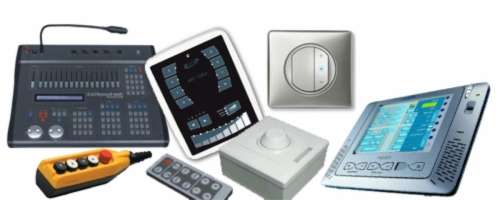
Lighting control can be organized different ways. This can be the control of all lighting fixtures in a house or apartment from one controller installed in convenient location, or from one remote control, allowing you to turn lights on and off in different rooms, and it is also possible to control the lighting in automatic mode according to a predetermined scenario or when the corresponding sensor is triggered. Most of the functions related to lighting control can be performed by the “ smart House" It is capable of combining all the systems that will be listed below.
Centralized lighting control
In very large houses and manufacturing enterprises For convenience, group panels are installed for centralized lighting control. For example, if the building of a bathhouse, guardhouse or barn is no longer needed, the lighting in them can be turned off from the main building from the central control panel. In this case, control can be carried out directly in hardware on a common panel, or perhaps on a separate special controller.
IN ordinary apartment sometimes they install a common controller near front door. When you're in a hurry getting ready for work, turning the lights on and off behind you is sometimes simply inconvenient, because you're rushing back and forth. And so, when leaving the house, you can press a button and turn off the lighting in the entire apartment at once.
The most convenient and advanced is centralized control from a computer or even from a mobile device in any part of the world. But this is already a remote control option.
Remote lighting control

Lighting can be controlled from a distance in a variety of ways. For the most common and accessible it is used lighting remote control, which looks very much like a regular TV remote control. Most often it has from 4 to 7 buttons, each can control one group of devices. Each group can have from 1 to 262 devices.
Using the remote control, you can not only turn on and off lighting fixtures in a particular room, but also adjust their brightness. For example, while lying in bed, you can turn off the overhead lighting and leave only the bedside sconce, or in the living room, dim the general light for a romantic dinner.
Using remote control of lighting in an apartment does not always make sense, since the need to turn on or off a particular lamp is in one way or another connected with moving around the apartment. For example, supporters of remote control always give an example of how convenient it is to turn off the light in the kitchen from the bedroom, which you forgot to turn off when leaving it. You might as well forget the remote control in the kitchen. And if several people live in an apartment, should everyone have their own remote control? How to determine who will turn off the light forgotten in the corridor? Or another example: remotely turning on the lights in the toilet and bathroom, how necessary is it? In any case, a light in the toilet may only be required with specific purpose visit it, what's stopping you from flipping the switch at the entrance? Well, if you are really lazy, then you can install motion sensors - the light will turn on when someone enters the room, and turn off when someone leaves.

The only more or less meaningful indication for using remote lighting control in the apartment is multi-tiered lighting when installed and ceiling lamps, and the central chandelier, and Wall lights, and sconces, and also decorative lamps in niches. In general, when you see a miracle of design thought. Then actually turning off some of the lighting in the room without getting up from the couch is convenient and advisable.
![]()
But the most justified is remote control of outdoor lighting. Top functionality - adjust lighting local area, technical buildings and alleys from one remote control, without leaving your home. Control decorative elements: illumination of flower beds, fountains, ponds and green areas is also very convenient to carry out from the “smart home” controller.
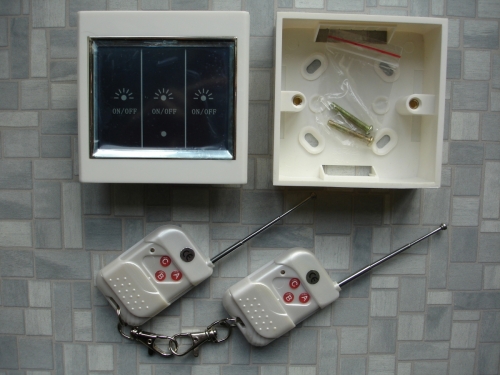
In addition to the large, full-fledged control panel, you can use small remote control - keychain with a limited number of functions. For example, just to open the gate and turn on the light near the front door of the house or in the garage.
Lighting control from a computer located in the same house, very convenient if there is no remote control nearby. Standard solutions software for the “smart home” system can be installed on a computer and be able to fully adjust all lighting groups and devices.
Lighting control from a computer anywhere in the world is carried out in this way: using a special program and password identification, you need to log directly into the home control device or intermediate server and turn on or off the lighting fixtures in a particular room. This is very convenient if you forget to turn off the light, or to create the effect of presence.
Lighting control using a smartphone provided using a special client software application. In many ways, this control is similar to the previous method, only from a less functional device.
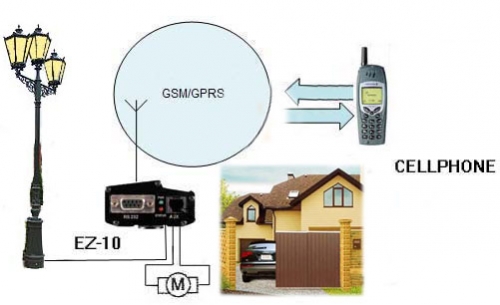
It is even possible to control it from a normal cell phone by sending encrypted SMS, this is called GSM control.
The easiest way to remotely control lighting is wall controller. When the last occupant of the home leaves the house, he can press a button and turn off the lights in all rooms. And when he comes home, the light turns on only in the hallway or corridor.
Automatic lighting control
Using automation such as motion sensors, photocells and timers to control lighting is very convenient. For example, in the corridor, toilet and bathroom you can install motion sensors and no longer bother wondering if I forgot to turn off the light in the toilet. According to the given program, a minute after they left it, the light will turn off by itself. The use of motion sensors is convenient if there are small children in the house who simply cannot reach the switches. And so the light will accompany them everywhere.
Allows you to adjust the intensity of artificial lighting depending on the general illumination. For example, with the onset of deep twilight, the lighting near the front door of the house and the illumination of alleys and paths are turned on. And with dawn, all artificial lighting turns off on its own.
Lighting control using timer used in cases where the lights need to be turned on and off according to the clock. For example, 5 minutes before the owner arrives from work, if he has a normal schedule. Or turning off lighting and outdoor advertising during dead time, from 02:00 at night to 05:00 in the morning.
Lighting control devices
Used to control lighting various devices and devices. Some of them are direct controls, others are auxiliary sensors or devices, receiving information from which the former are triggered.
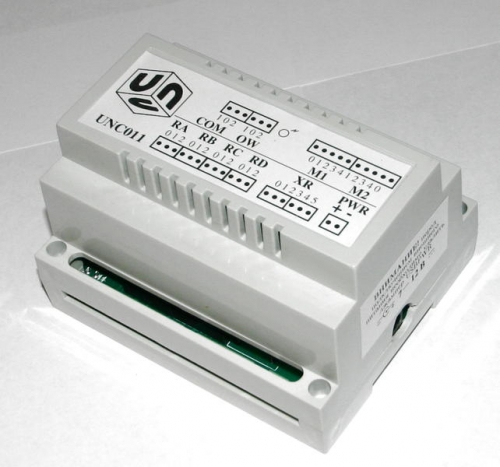
Used to remotely control a group of luminaires. Connects to lighting fixtures specific group. When you press the button, it turns the devices on or off forcibly.
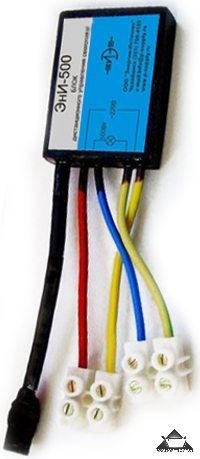
There are also blocks that allow you to control a lighting group using a regular remote control from a TV or other equipment. The buttons on the remote control can be selected arbitrarily and then programmed for specific actions. The block allows you not only to turn the light on and off, but also to adjust the brightness, as well as turn off the light using a timer.
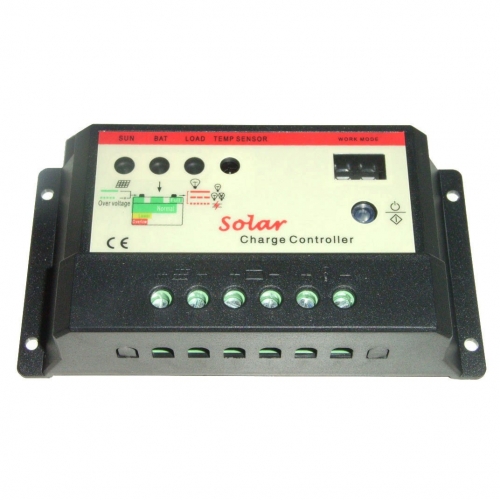
The controller is a functionally complete automatic machine, capable of controlling lighting in automatic mode according to a given program, in remote mode from the remote control or according to information received from sensors, as well as in manual mode using buttons. Programming of the controllers is carried out using the built-in keyboard and LCD display.
The lighting control circuit using the controller is shown in the figure.

Lighting control sensors
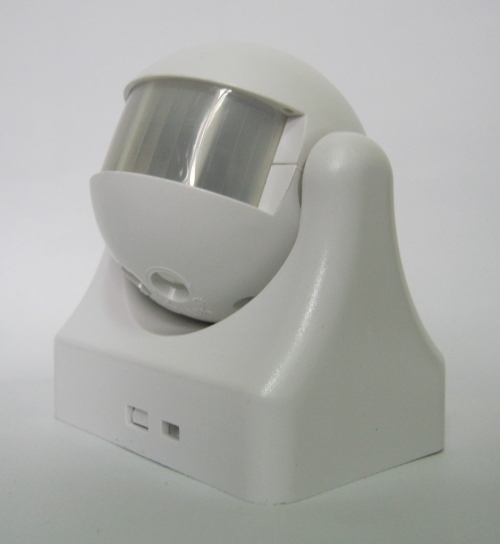
Installed in rooms where automatic control of light is planned depending on the presence of people in it. Pyrosensors of the sensors detect thermal radiation from people and animals, send a signal to the control device, which turns on the light or turns it off if the room is left. The operating principle of motion sensors is based on IR radiation (infrared), which does not pass through natural barriers such as walls. If there is someone in the next room, the sensor will not trigger.

Capture light flux natural light. If the intensity decreases to a predetermined threshold, the sensor transmits a signal to the control device, which turns on the lighting, for example, in the evening or cloudy times. Such sensors are mainly used only for automatic control external lighting of alleys, technical lighting of buildings, terraces, etc.
Remote controlled switches

Like modern TVs, stereo systems, DVD players and other devices controlled using infrared rays, the first to appear were switches, sockets and dimmers that respond to infrared rays. Control occurs using an infrared remote control, which must be pointed clearly at the IR receiver on the switch. In this regard, control is possible only within line of sight, but not in other rooms.
Radio controlled switches allow you to control lighting in different rooms and beyond at a distance of up to 100 m through any obstacles that reduce the signal level, but do not block it completely. The frequencies used for radio control of lighting, 433 MHz and 868 MHz, are specifically designed for this purpose, so that air pollution does not occur. Sometimes special adapters are produced that convert IR radiation into radio frequency.
GSM controlled switches allow you to control lighting from your phone remotely. Using a special program installed on your phone or smartphone, you can turn off or turn on the lights in the house, no matter where you are.
Lighting control panel
For remote control of lighting, both IR and radio-controlled remote controls are used. In some cases, you can use a regular TV remote control by reprogramming it accordingly.
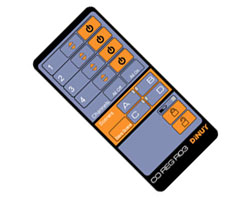
Radio-controlled remote controls are now in demand, as they have sufficient functionality. They can have up to 7 - 9 buttons that can control different groups lighting. Each group has its own address. When you press the button, the signal goes out to all groups at once, but only the group whose address matches is responded.

Smart home systems use remote controls that allow you to regulate and control not only lighting, but also all appliances and electronics in the house.
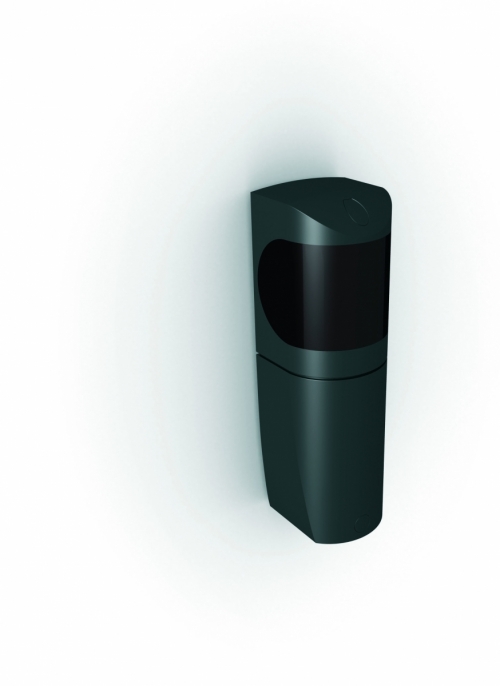
Photocells must be installed in places where there will be no illumination from lamps, so that false alarms do not occur. The device does not respond to temporary flashes, such as lightning or car headlights, only to the general level of illumination.
Timers or time relays
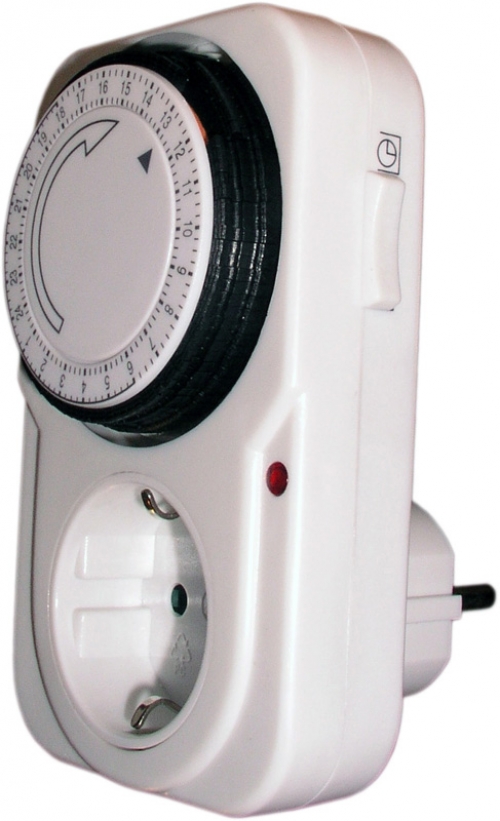
A time relay is used when it is necessary to control lighting according to a specific schedule. For example, outdoor advertising lighting needs to be turned on at a certain time and turned off too. Street lighting garden or local area should be turned off at night and turned on again before dawn. The built-in processor itself determines the time of sunrise and sunset and calculates the required time.
All these devices and appliances are designed to simplify our lives and make it even more comfortable. The most simple systems remote lighting control does not require replacement of wiring or additional wires; it is enough to replace switches or install special blocks into the chandeliers. But for more serious control using the smart home system, you will have to form a serious network connecting all devices.
This article, without unnecessary introductions, tells you how to repair a chandelier with a control panel with your own hands. It is assumed that the reader is familiar with the design and connection of this type of chandelier.
Attention! For those who do not know how such a chandelier works and how to install it - Article about. I recommend everyone to check it out!
There are also a lot of real malfunctions and repair recommendations in the comments to this article.
DIY chandelier repair
The main news is that the components for repairing such chandeliers cost pennies. At the end of the article there are links on where and how to buy spare parts for chandeliers by mail, through AliExpress. The only negative is that you have to wait, from 20 to 40 days...
There are actually only two faults in such chandeliers, and both can be fixed with your own hands, now I’ll tell you how.
A chandelier with a remote control does not turn on using the remote control or switch
This is the most frequent malfunction— the chandelier does not turn on at all. We must first check the obvious - the batteries in the remote control and the power supply to the chandelier. The switch may be faulty or there is no contact on the ceiling.
Chandelier with remote control clicks but does not turn on
Clicks when trying to turn on from the remote control or from the switch indicate that most likely the chandelier controller is working. As a rule, not all groups are included at once, but only one or two.
Each lighting group is switched on by its own controller output. And since the controller output has a voltage of 220 V, then to power the LEDs and halogen lamps are used additional blocks nutrition. You need to make sure that when you turn on the corresponding group, a voltage of 220V appears at the input of the desired power supply. If there is no voltage at the output, either this unit is faulty or the output is short-circuited.
Below are diagrams and real examples, it will be clearer.
Repair often comes down to replacing the control panel complete with receiver, controller, electronic transformers and is not particularly different from the repair of other chandeliers.
A couple of things to renovate
It also happens that when one group in a chandelier does not turn on, the problem is in the LEDs connected in series. If a break occurs in one of them, then all of them do not burn.
In addition, I would like to warn against installing overly powerful halogen lamps. This will either burn out the transformer or the cartridges. And changing the cartridges in such chandeliers is the most difficult thing to repair.
Changing the controller often is expensive, difficult and not particularly necessary. In this case, I suggest removing the chandelier control unit with the remote control altogether, and connecting the lighting groups through a regular switch. Cheap, in our opinion.
Replacing the controller (chandelier control unit)
Below is an example of a diagram of how you can completely remove the controller from the chandelier and connect the chandelier without a remote control, through a regular switch. In other words, give a broken chandelier a second life.

Chandelier controller (receiver unit)
Here are the connections that occur in the chandelier controller for 2 lighting groups:
![]()
Controller. Scheme of a chandelier with a remote control.
In fact, the receiver (controller) contains two relays that turn on one or the other lighting group in the chandelier. The normal one does the same two-gang switch, which is in any apartment.
Only the switch is acted upon by the hand, and the receiver is acted upon by the radio signal sent by us from the control panel.
There are two wires coming to the controller's power input - phase through the switch and zero (sticking out from the ceiling). Next, the zero (black) goes through the controller to the zeros of the light bulbs (still black). A Phase (red) - through the relay contacts to the phases of the light bulbs (blue and white).
Maybe this will be interesting:
Light bulbs are usually turned on not directly (220V), but through power supplies. But this does not change the essence of the matter.
And so, if the controller is broken, you don’t have to change it (the pleasure is about 1000 rubles, plus work, especially since it needs to be changed in tandem with the remote control), but simply throw it away. And connect the chandelier according to the usual scheme:
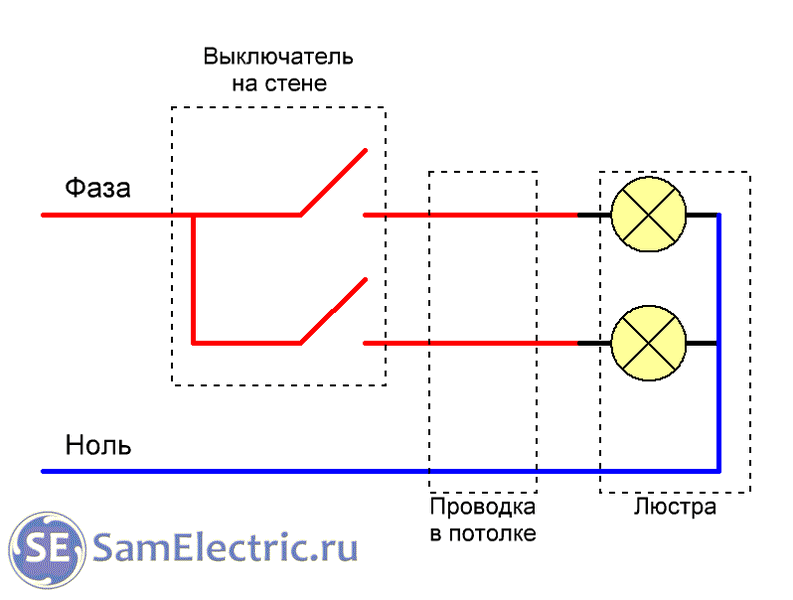
This classic scheme connecting the chandelier via a two-key switch.
Chandelier controller repair
If all else fails, you don’t want to reduce the functionality of the chandelier, and you don’t have the means to change the controller; you can try to repair the controller yourself. , which discusses in detail the electrical circuit diagram of a typical controller, recommendations for troubleshooting common faults are given, and an example of a real repair is given.
As my practice shows, the probability of successful controller repair led chandelier quite high.
Chandelier controller with three outputs
And here is a circuit diagram of a controller with three outputs, sent by reader Alexander on 10/31/2015:
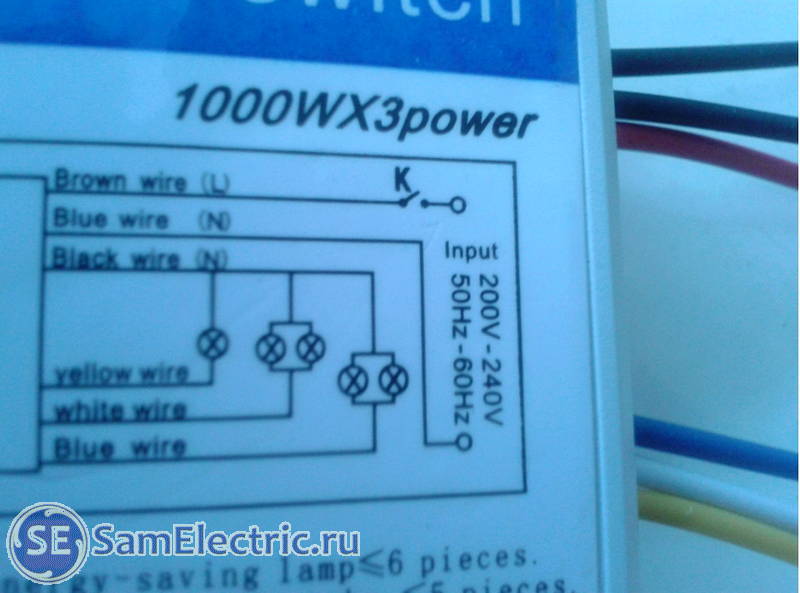
The diagram shows:
- K - wall switch through which phase is supplied to input L (brown wire)
- N - input neutral (zero) wire blue color
- N - blue output neutral (neutral) wire, directly electrically connected to input N on the controller board, used to power light bulbs
- Yellow, White, Blue - outputs (phases) for powering three groups of light bulbs.
Groups of lamps are turned on sequentially, in accordance with the program embedded in the controller. To change the sequence of switching on groups of light bulbs, just connect them to the desired controller outputs.
All outputs are 220V. If light bulbs for a different voltage are used, then the light bulbs are not connected to the controller outputs directly, but through the necessary power supplies (adapters).
Another example of filling a chandelier
Elena the Beautiful, write your name in more detail (at least Elena 123)! I have more than 10 people on my blog Elen) This applies to everyone!
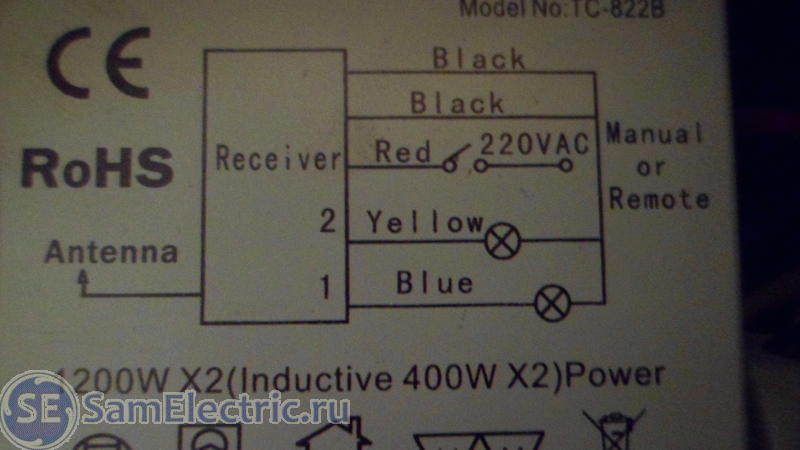
Receiver - controller - remote switch
Here is a block that can be called whatever you like, but it does the following. The antenna receives the signal from the remote control. Depending on the signal (the button pressed on the remote control), either a group of light bulbs connected to the yellow wire (Yellow, one light bulb is conventionally shown), or a group connected to a blue wire, or both groups are turned on. The red wire is supplied with phase through the wall switch, and the black wire is supplied with zero.
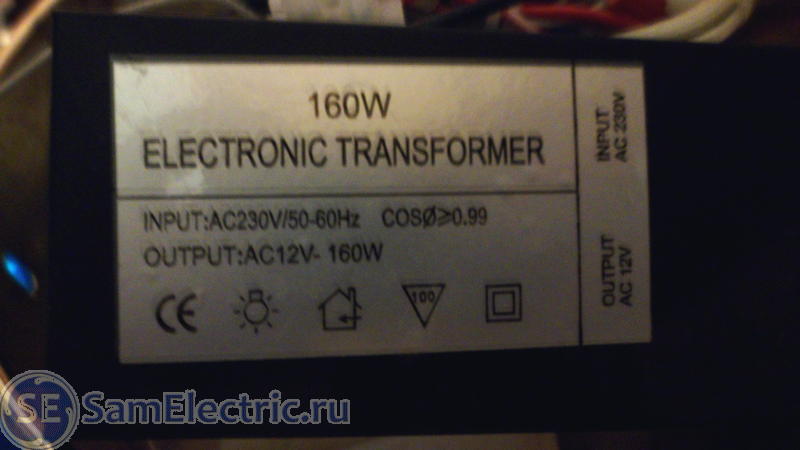
Such a transformer can power up to 8 light bulbs with a power of 20 W each.
The repair is as follows.
- Make sure that the chandelier receiver controller “hears” the commands sent from the remote control. This can be done by ear; the moment the relay turns on is clearly audible.
- Make sure that when the outputs are turned on, a voltage of 220V is present at them relative to zero (N).
- Make sure that this voltage is supplied to the power supplies of the lighting groups.
- Make sure that the outputs of the group blocks have the required voltage. The output voltage is indicated on the block stickers.
- Check the electrical wiring from the blocks to the light bulbs
- Make sure the light bulbs are working properly.
At each stage, draw conclusions about the necessary replacement and repair.
Example of chandelier repair
What is shown here is not exactly a repair, but one might say a modernization towards simplification.
The photo below was sent to me by a reader:
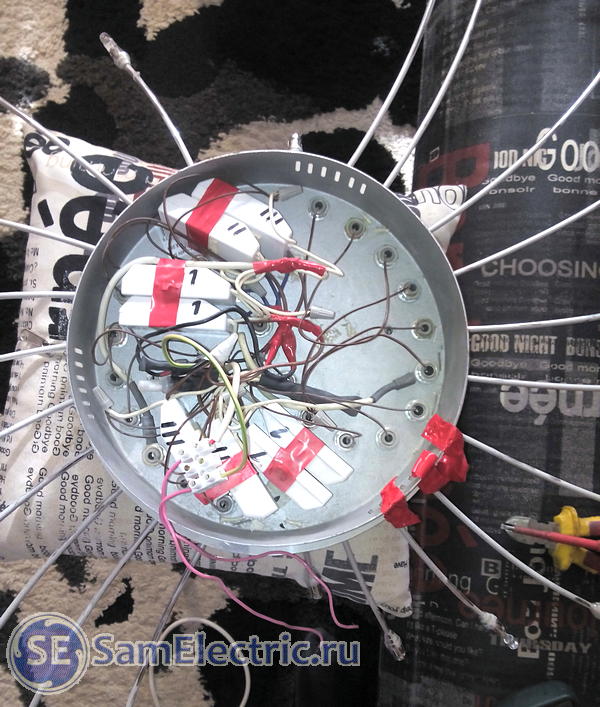
The chandelier does not contain LEDs at all, however, the principle of its operation and repair is absolutely the same. A reader complained to me in a letter that the chandelier began to respond poorly to commands from the remote control. I advised changing the controller. However, the reader admitted that he does not like remote bells and whistles, and he is not going to spend more than 800 rubles (control over 3 channels).
As a result, on my advice, the radio control unit was completely excluded from the chandelier, and power was supplied from a conventional three-key switch.
It is worth saying that before this, the electronic transformers of halogen light bulbs were replaced, and some groups had to install 2-3 transformers instead of one, because there was no suitable one in terms of power and dimensions.
That's all, good luck and good lighting everyone!
LED lighting continues to successfully capture the global market, providing excellent energy efficiency along with flexibility and versatility in use. However, LED lights are still expensive to manufacture due to the high cost of LEDs and the design of the heatsinks. However, rather than competing with other light sources on energy savings alone, LED product manufacturers are trying to differentiate themselves in the market by offering more sophisticated features.
LED lighting control system components and prices
Control LED lighting carried out using a number of components:
- RGB controller (from the English Red, Green, Blue - Red, Green, Blue) - a single-channel controller with a built-in LED driver, which allows you to control the three above-mentioned colors using the programs built into it;
- Multi-channel RGB controller – has several channels (three or more) of LED lighting control, which allows it to perform complex lighting scenarios;
- DMX RGB controller is a device that connects LED lighting to a computer via the DMX 512 protocol. In this case, the light is controlled using special software. The device allows you to use up to 512 light control channels;
- DALI RGB controller – allows you to control large LED systems via the DALI protocol. Using this controller makes it possible to manage 12,800 devices at once;
- Dimmer – is a device for adjusting the brightness of light. Our website is dedicated to dimmers, so we won’t dwell here for long;
- Repeaters are unique amplifiers for RGB controllers that allow you to increase their power.
Here approximate prices to some of these devices
As you can see, there are devices for every taste and color. Now let's talk a little about the LED products themselves.
Flexibility and functionality of LED products
For example, LED lights can easily provide various colors, that is, the same lamp can emit warm or cold White light or any color in the spectrum. Compact fluorescent lamps cannot provide a similar opportunity. LED lights are also “smarter” due to communication capabilities, which allows them to work better, offering more flexible control, diagnostics and automation of some functions. One of the most global systems is the Powerline network, which provides the communication interface and serves as the main element.
Modern technologies allow the use of special tires that provide high level reconfigurability and the ability to control multiple devices through one controller. This controller can control all the light bulbs and fixtures in a room or even the entire house. In addition, the bus topology allows the use of several controllers to control one luminaire. Thus, a lamp in one room can be controlled from another (that is, all lamps in the house can be turned off, for example, from the bedroom). This topology also allows the controller to keep track of all devices on the network and serves as a basis for expansion and has a plug-and-play feature where any new luminaire can immediately become part of the network.
Powerline system
Powerline includes a transceiver, usually low voltage, with power direct current. To interface this device with Powerline, an amplifier and communication circuit are not required. The communication circuit can be modified to support the required voltage range (e.g. 110-240V alternating current for residential applications, 24 VDC for swimming pool lighting, etc.) and therefore the Powerline transceiver can be used for any desired voltage range.
The appearance of the controller can be very diverse, depending on the location and level of control that is required. Located on the wall, the lighting control interface can have appearance a simple switch, as well as one or more dimmers for individual color control of luminaires. In addition, sometimes a button is needed to index existing luminaires and one button to bind to a network node.
Typically, a microcontroller is used to process these functions and integrate them into the Powerline transceiver interface. With Cypress Powerline communication technology, for example, the microcontroller and transceiver are integrated so that data processing, network communications and the lighting control system are controlled by a single device.
An innovative approach to replacing clunky physical buttons, switches and dimmers is the use of capacitive touch sensing, which provides the user with an easy, convenient and reliable interface to control the lighting in the home.
Video: Remote lighting control




